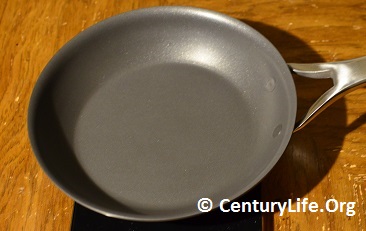Nonstick pan popularity has waned as people have become aware of potential health risks from using nonstick materials at high heat. One alternative to nonstick pans is to use cast iron pans and to “season” them with cooking oil. At high enough temperatures, cooking oils will polymerize, and with enough layers of such polymers you wind up with a thin film of plastic-like, somewhat nonstick material. Over years of use, cast iron will accumulate more and more layers of polymerized oils on the cast iron’s cooking surface. The more layers, the less iron-leaching and the more nonstick the cast iron will become. Even the best-seasoned cast iron is not truly nonstick, but it’s good enough for many people–even for notoriously sticky foods like eggs and fish. [Read more…]
Cookware Material: Aluminum (Aluminium)
Cooking surface: 2/5 Poor (4/5 Very Good if anodized)
Conductive layer: 4/5 Good (5/5 Excellent if over 3.5 mm thick or with thick conductive disc base)
External surface: 2/5 Poor (4/5 Very Good if anodized)
Example: Anolon Nouvelle Copper Nonstick
Health safety: 4/5 Good (5/5 Excellent if anodized)
—–
DESCRIPTION
Compared to other metals, aluminum (also known as aluminium1) is highly thermally conductive (pound for pound, aluminum delivers the highest thermal conductivity of all cookware materials), cheap, and low-density, but not particularly hard or strong. Heat treatment and other techniques can strengthen and harden aluminum, but such techniques can also make machining and forming pots and pans harder as well. [Read more…]
Thermal Properties of Metals
WHY DO WE WANT EVEN HEATING AND WHAT CAN WE DO ABOUT IT?
The job of the stovetop cookware is to smooth out the uneven heat coming from the burner underneath so that the cooking surface of the cookware is the same temperature. If you have too much of an imbalance in temperatures, you wind up with hot spots that can undermine your dish and your health by leaving some food overcooked (or even charred and carcinogenic) and some food undercooked. For instance, if you put a poor thermal conductor on a burner, the heat from the burner will keep accumulating near the areas where the flames touch the cookware because the cookware can’t spread the heat across the entire pan’s base fast enough.
HEAT TRANSFER
There are three ways to move heat from one place to another: convection, radiation, and conduction. [Read more…]
Cookware Material: Stainless Steel (Inox)
Cooking surface: 4/5 Good
Conductive layer: 1/5 Very Poor
External surface: 5/5 Excellent
Examples: Exterior and interior of All-Clad Stainless, Demeyere
Health safety: 5/5 Excellent
—–
DESCRIPTION

Stainless steel is also known as “stainless.” Since a lot of cookware is manufactured in French-speaking countries, you may see the terms “acier inoxydable” or “inoxydable” or “inox” which mean all mean “stainless steel.”
So what is stainless steel?
The short story: stainless steel is a corrosion-resistant type of steel. It’s much harder and has a much higher melting point than aluminum and copper, making it the most durable of all common cookware materials. (Porcelain/ceramic/glass and anodized aluminum are harder than stainless steel, but they are also brittle, making them more likely to break if dropped or bashed against the side of a sink or other hard surface.)
However, stainless steel is not 100% corrosion-resistant. Even the most corrosion resistant grades of stainless steel will eventually pit/stain/rust if exposed to salt water or acid for long enough periods of time. Thus you should never store acidic foods (e.g. tomato sauce) in stainless steel pots overnight. Also do not use undissolved salt as that is highly corrosive, and even the best grades of stainless steel can’t resist that abuse indefinitely. For instance, when making pasta, bring water to a rolling boil first before adding salt. The agitated water will prevent salt from sinking to the bottom of the pot before it has a chance to dissolve. Stainless steel cookware can last a lifetime–with proper care.
If you’re shopping for stainless steel kitchenware, the hierarchy goes something like this:
Cookware Material: Is nonstick safe? Is Teflon safe? Are PTFE and PFOA safe? What about ceramic or titanium nonstick?
Cooking surface: 5/5 Excellent (slippery nonstick, browning can be a challenge especially if dark surfaces make it hard to see what you’re doing)
Conductive layer: 1/5 Very Poor (note that PTFE coatings are very thin so it will not impede the performance you receive from the underlying conductive material, which is usually aluminum)
External surface: 1/5 Poor (fragile and can offgas starting at 400F, at levels of concern to humans at 450-500F+; must keep away from fire from natural gas stoves)
Example: Dupont Teflon, Whitford Xylan
Health safety: 2/5 Poor (can offgas starting at 400F, at levels of concern to humans at 450-500F+)
—–
DEFINITIONS

PTFE stands for polytetrafluoroethylene. DuPont owns the trademark for Teflon, which is a specific type of PTFE. PTFE is an artificial chemical that you can think of as extremely slippery plastic. To prevent PTFEs from flaking off or abrading easily, cookware manufacturers often construct an aluminum pan like so:
- start with a base layer of aluminum and form it into the shape of a pan
- roughen the cooking surface (e.g., spray molten metal and/or ceramic onto it, or etch ridges on the cooking surface), which helps PTFEs adhere to the cooking surface
- apply PFOAs and PTFEs on the cooking surface
- bake the pan, which cooks off almost all of the PFOAs and leaves just the super-slick PTFE surface. (PTFE is so slippery that it does not like to bond to metal, hence the use of PFOA.) [Read more…]